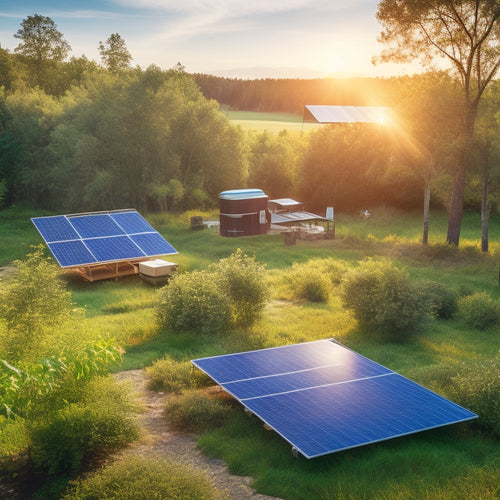
7 Best Off-Grid Solar Mounts for Yurts
Share
When it comes to off-grid solar power for your yurt, choosing the right mounting system is vital. You'll want to take into account roof-mounted solar racking systems, which require verifying your yurt's roof weight capacity and stability, or ground-mounted solar panel arrays, which need assessment of ideal array size and soil condition. Adjustable solar panel tilt frames can optimize energy production, while solar canopy and carport mounts provide shelter and support for larger systems. Yurt-integrated solar roofing solutions, portable and foldable solar racks, and DIY solar mounting kits offer alternative options. As you investigate these options, you'll find the perfect fit for your off-grid energy needs.
Overview
- Assess yurt's roof weight capacity and stability to support solar equipment and snow load for roof-mounted systems.
- Choose a mounting system durable against wind, snow, and compatible with soil type for ground-mounted arrays.
- Consider array size, efficiency, and orientation to meet yurt's energy requirements and optimize energy production.
- Select a mounting system that withstands harsh weather conditions and is adjustable for ease of installation and maintenance.
- Evaluate specialized solar mounting solutions, such as yurt-integrated solar roofing or portable and foldable solar racks, for unique yurt needs.
Roof-Mounted Solar Racking Systems
How much weight can your yurt's roof handle? When considering roof-mounted solar racking systems, this is an essential question.
You'll need to verify your yurt's roof stability can support the combined weight of the solar panels, racking system, and snow load (if applicable). Many solar kits, including high-efficiency solar panels, are designed to provide peak energy production, making them a great option for off-grid energy.
Look for systems with a low profile and sleek design to minimize wind resistance and stress on your yurt's roof.
Installation tips: always follow the manufacturer's instructions, and consider consulting a professional if you're not experienced with roofing or solar installations.
A well-installed roof-mounted system can provide a reliable source of off-grid energy, granting you the freedom to live life on your own terms.
Ground-Mounted Solar Panel Arrays
When designing a ground-mounted solar panel array for your yurt, you'll need to evaluate the ideal array size to meet your energy needs, factoring in aspects such as high-efficiency panels to maximize energy harvesting.
You'll also need to choose a mounting system that can withstand environmental factors like wind and snow, and confirm it's compatible with your soil type.
Factors like soil condition, density, and moisture levels will also impact the installation process and overall system performance.
Array Size Considerations
You'll need to size your ground-mounted solar panel array to meet your yurt's energy demands. This involves calculating your daily energy requirements and determining the number of panels needed to meet those needs.
Reflect on factors like array efficiency, which can be affected by panel orientation and shading. A south-facing array with an ideal tilt angle will generally produce the most energy. However, you may need to compromise on orientation or tilt to accommodate your yurt's location or surrounding environment.
When designing your array, it's crucial to reflect on energy harvesting strategies and high-efficiency solutions(https://www.illchanterhislater.com) to maximize energy capture.
Be sure to also reflect on the physical space available for the array, as well as any local building codes or regulations that may impact your design.
Mounting System Options
With your array size determined, it's time to focus on the mounting system that will securely fasten your ground-mounted solar panel array to the ground.
You'll need to choose a mounting system that suits your terrain and climate. Consider factors like wind load, snow load, and soil type when selecting mounting hardware.
You'll want to make sure your system can withstand harsh weather conditions and last for years to come. Look for mounting systems with durable materials, sturdy frames, and adjustable legs for easy installation.
Research installation techniques, such as anchor points, concrete footings, or helical piers, to make certain a secure and level installation.
Soil Condition Factors
Soil condition is an essential factor to evaluate when designing a ground-mounted solar panel array for your yurt.
You'll want to assess the soil stability to guarantee it can support the weight of the panels and mounting system. Moisture levels, drainage patterns, and frost depth also play a significant role, as they can affect the soil's ability to support the array.
Additionally, consider the erosion potential, nutrient content, and compaction effects of the soil, as these can impact the long-term stability of the system.
Moreover, think about the vegetation impact, as certain plants can interfere with the array's performance or compromise the soil's integrity.
Adjustable Solar Panel Tilt Frames
You'll find adjustable solar panel tilt frames offer a range of tilt angle options, allowing you to optimize energy production based on your yurt's location and seasonal changes.
These frames are typically made from durable materials like anodized aluminum or stainless steel, guaranteeing they can withstand harsh outdoor conditions.
When selecting an adjustable tilt frame, consider the frame material's corrosion resistance, strength, and weight capacity to ascertain it can support your solar panel array.
Tilt Angle Options
Adjustable solar panel tilt frames offer a range of benefits for yurt dwellers. You can maximize your solar efficiency by adjusting the tilt angle to match the season.
During winter, you'll want a steeper tilt to amplify energy production, while a shallower tilt is better for summer. This flexibility guarantees you're generating power at the best level year-round.
When installing your solar panels, consider the panel orientation and potential shading impacts from nearby structures or trees.
Regular maintenance tips include adjusting the tilt to account for weather considerations, such as heavy snowfall or intense sunlight. By doing so, you'll confirm your system operates at peak performance, providing you with the freedom and independence you desire.
Frame Material Choices
When selecting adjustable solar panel tilt frames for your yurt, the frame material choice plays a significant role in the overall system's durability and performance.
You'll want to take into account aluminum frames, which offer excellent corrosion resistance and weight distribution. Steel supports provide added strength, while composite materials offer a durable, low-maintenance option.
If you're looking for a more rustic approach, wood structures can be a viable choice. However, keep in mind that wood requires more maintenance and may not be as durable as other options.
Installation ease and cost factors are also essential elements to weigh. Reflect on the overall system's performance, your budget, and the level of maintenance you're willing to commit to when choosing the best frame material for your off-grid solar setup.
Solar Canopy and Carport Mounts
A yurt's compact footprint and remote location make it an ideal candidate for a solar canopy or carport mount, which provides both energy independence and a protective shelter for your vehicle or outdoor space. These mounts offer a unique opportunity to maximize your solar energy production while also creating a functional outdoor area. When choosing a solar canopy or carport mount, consider the following key factors:
| Feature | Canopy Design | Carport Benefits |
|---|---|---|
| Energy Production | Ideal for smaller systems | Supports larger systems |
| Structural Integrity | Lightweight, durable frames | Sturdy, reinforced structures |
| Versatility | Customizable sizes and shapes | Integrates with existing infrastructure |
Yurt-Integrated Solar Roofing Solutions
Three key advantages make yurt-integrated solar roofing solutions an attractive option for off-grid dwellers: seamless integration, increased energy production, and enhanced structural integrity.
You can design your yurt with solar panels as an integral part of the roof, eliminating the need for separate mounting systems. This approach not only streamlines the installation process but also maximizes energy efficiency by minimizing energy loss due to shading or obstruction.
Additionally, yurt-integrated solar roofing solutions can strengthen the overall structure by providing an additional layer of protection against harsh weather conditions.
Portable and Foldable Solar Racks
You may not always need a permanently installed solar roofing solution for your yurt. Sometimes, you want the flexibility to move your solar panels or take them with you on the go. That's where portable solar solutions come in.
Portable and foldable solar racks are designed to be lightweight, compact, and easy to set up. They often feature foldable panel designs that can be easily stowed away in a carrying case.
These systems are perfect for yurts that are frequently relocated or for those who need to supplement their power supply in different locations. With portable solar racks, you can enjoy the freedom to roam while still utilizing the power of the sun.
They're a great option for yurts that require occasional repositioning or for those who want to investigate off-grid journeys.
DIY Solar Mounting Kits for Yurts
Since yurt owners often require customized solar solutions, DIY solar mounting kits have become increasingly popular. You can design and install a system that meets your specific needs, guaranteeing peak yurt energy efficiency. These kits usually include adjustable brackets, clamps, and rails, allowing you to securely fasten your solar panels to your yurt's roof. Be certain to research local solar panel regulations before installation.
| Kit Feature | Description | Benefits |
|---|---|---|
| Adjustable Brackets | Allow for tilt and angle adjustments | Maximize energy production based on seasonal changes |
| Clamps and Rails | Securely fasten panels to yurt roof | Guarantee safe and stable installation |
| Customizable Design | Tailor the system to your yurt's unique shape and size | Maximize energy output and minimize waste |
| Weather-Resistant Materials | Withstand harsh outdoor conditions | Extend the system's lifespan and reduce maintenance |
| Instructional Guides | Provide step-by-step installation instructions | Simplify the DIY process and reduce errors |
Frequently Asked Questions
Can I Install Solar Panels on a Yurt With a Curved Roof?
When installing solar panels on a yurt with a curved roof, you'll need to take into account unique curved roof considerations, such as angled mounting systems and specialized panel installation techniques to guarantee a secure and efficient energy harvest.
Do I Need a Permit to Install Off-Grid Solar on My Yurt?
You'll need to check local regulations regarding off-grid solar installations, as permits and installation guidelines vary by region; research and comply with these rules to guarantee a safe and legal setup for your yurt's solar system.
How Do I Secure My Solar Panels From Theft or Vandalism?
You prioritize panel security by installing tamper-evident screws, anchoring systems, and motion-sensitive cameras to deter theft and vandalism, ensuring your off-grid freedom isn't compromised by malicious activity.
Can I Use a Solar Mount Designed for RVS on My Yurt?
You can use an RV solar mount on your yurt, but ascertain compatibility by considering yurt roof types, such as fabric, metal, or vinyl, and the mount's clamping system to secure your panels safely and efficiently.
Will Snow Accumulation Affect the Performance of My Solar Panels?
You'll want to take into account snow load on your solar panels, as it can reduce panel efficiency by up to 50%. Make sure to choose a mount with a tilting feature to allow snow to slide off, ensuring ideal energy harvesting even in winter.
Ready to Buy
You've finally made it to the end of this exhaustive list, and by now, you're probably overwhelmed by the sheer number of options for off-grid solar mounts for your yurt. Good luck deciding which one to choose - you'll need it. Just remember, the fate of your off-grid yurt paradise rests on the stability of your solar panels. No pressure.
Related Posts
-

How to Achieve a Zero-Waste Lifestyle for a Greener Tomorrow
To achieve a zero-waste lifestyle, start by adopting the principles of refusing, reducing, reusing, and recycling. Sw...
-

Replacing Old Appliances With Sustainable Alternatives
Replacing old appliances with sustainable alternatives can change your home into an energy-efficient space. Not only ...
-

Top Off Grid Solar Batteries for Renewable Energy
When seeking top off-grid solar batteries for renewable energy, consider options with advanced battery chemistry, suc...


